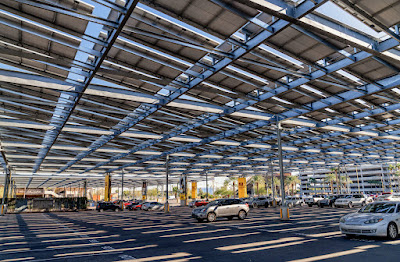This morning on WAMC, Earth Wise featured a podcast called "Solar Canopies"--a subject that is very timely for us here in Hudson.
It argues that putting solar panels on parking lots "has the appeal that they are abundant, close to electricity customers, and are on land that already has been stripped of much of its biological value." There is also the benefit of providing shade and shelter for cars.
Granted Hudson doesn't have the seas of parking lots that are found at the shopping malls of Greenport, but surely there is enough space given over to parking lots (the city lot at the train station comes to mind) to allow us to avoid sacrificing the rare and precious undeveloped open space that exists in and around North Bay.




Excellent idea
ReplyDeleteThese exist in Italy along the highway rest stops places. In Oct 2019 I saw them . Not only do they make power, they shade parked vehicles from sun and rain.
ReplyDeleteThank you for posting this Carole, I also heard the Earth Wise report on AMC this morning and felt that it underscored my position on Solar in the City: We should explore every option in siting solar arrays on the hard surfaces of the city, rooftops + parking lots ,before entertaining land-based solar on open space.
ReplyDeleteAlso the Columbia Land Conservancy has had a long time plan, designed by Starr Whitehouse, for the former landfill to become a conservations area with pedestrian trails. This plan was created (at great expense and with expansive research) with the understanding and the blessing of both the County and the City.
While I am completely behind alternative energy capture and getting away from fossil fuel based energy, to use what little open space we have in our mere two-square miles for Industry, which solar farms are, Industry, is not appropriate land use.
The Solar Canopy parking lot option is one that is expensive especially with current steel prices. The incentives for solar canopies are not currently favorable for municipalities. I have hope that a Build Back Better Bill, when passed, will include the proposed changes that offer incentives to municipalities for installing solar, thereby reducing city energy costs paid by tax payer dollars and reducing carbon footprint.
Another thing all municipalities could do:
I feel that every municipality should pass building code requirements for all new commercial developments to generate "X amount of clean energy per Y square footage of property", or an equivalent mitigation, resulting in reduced fossil fuel use. Example: Walmart in Greenport should have been required to produce a minimum of 3MW of solar energy, from the rooftop or the parking lot. The system would pay off quickly for such large consumers of energy.
It would be great to hear from more people on these ideas and other ideas.
To a greener New Year,
Hilary
Well said and explained, Hilary. Greenport has acres of big box rooftops and parking lots that could be utilized for this purpose. Perhaps Columbia County supervisors should support this and push developers in that direction instead of using up open green fields. Fingers crossed for the Build Back Better Act.
DeleteCertainly an interesting notion, and if indeed the priority is to reduce our carbon footprint, this makes a lot more sense than building on green space, which as the podcast points out, is important for carbon sequestration, wildlife habitat, and dwindling recreation space.
ReplyDeleteThe podcast also points out that it is currently more cost-effective to build on undeveloped land, and balancing out profit motive with environmental and community concerns doesn't seem like an exercise this administration is very good at.
David Konigsberg submitted this comment by email:
ReplyDeleteSeriously, not enough can be said for leveraging as much North Bay land as possible for public/conservation use, given the city’s density and paucity of public open space. In particular, the proposed trail system, shelved (temporarily, we hope), would create in-town access to the natural world and connect the city directly to the 625-acre Greenport Conservation Area, one of the area's largest public landscapes, without the need of a car. This would make it a tremendous urban asset, increasing equity in our quality of life and adding another big reason to live, work, stay and invest in Hudson.